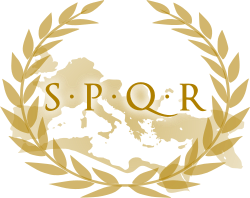| Politics of the Roman Republic | ||||||||||
|---|---|---|---|---|---|---|---|---|---|---|
 | ||||||||||
| 509 –27 BC | ||||||||||
| Constitution and development | ||||||||||
| Magistrates and officials | ||||||||||
| ||||||||||
| Senate | ||||||||||
| Assemblies | ||||||||||
| Public law and norms | ||||||||||
| ||||||||||
The Roman assemblies were meetings of the Roman people duly convened by a magistrate. There were two general kinds of assemblies: a contio where a crowd was convened to hear speeches or statements from speakers without any further arrangements and a comitia where citizens were called and arranged into voting blocks. [1]
Contents
- Comitia
- Curiate assembly
- Centuriate assembly
- Tribal assembly
- Plebeian council
- Contio
- See also
- References
- Bibliography
- External links
When called to enact legislation or make decisions, such as on guilt or war, citizens were in the historical period always divided into voting blocks. Citizens voted directly in these blocks, with a majority of the blocks determining the decision of the assembly; this system was directly democratic with no representatives. There were three kinds of voting blocks – curiae, centuriae, and tribus – giving rise, respectively, to the curiate, centuriate, and tribal assemblies. In the middle and late republics, only the centuriate and tribal assemblies were politically relevant.
The assemblies elected all magistrates during the Roman Republic. They also had plenary authority to make laws, [2] but only exercised this authority in accordance with procedures buttressed by Roman religious practices. Prior to a voting assembly, notice had to be given. On the day thereof, the presiding magistrate took auspices with the gods. When the people were summoned a prayer was conducted and the matter at hand introduced. Speakers invited by the presiding magistrate then could be given; citizens in the assembly had no presumptive right to participate except by listening to the proceedings. When the president called the people to vote, they did so by blocks with a result announced when a majority was reached. [3]
The curiate and centuriate assemblies date to the regal period. Their functions in this early period are poorly documented but mainly relate to the election on the Roman monarch. After the overthrow of the Roman monarchy (dated traditionally to 509 BC) the centuriate assembly is said to have elected the magistrates that would become the consuls, with the tribal assembly being formed shortly after the creation of the republic. The plebeian council, on the other hand, was formed and became coequal with the other assemblies over the course of the Conflict of the Orders. The fall of the republic did not mean that the assemblies stopped to meet. However, their importance quickly diminished as the emperor accrued direct legislative power and the senate became the de facto electoral assembly. The assemblies had become entirely obsolete by the third century AD.

